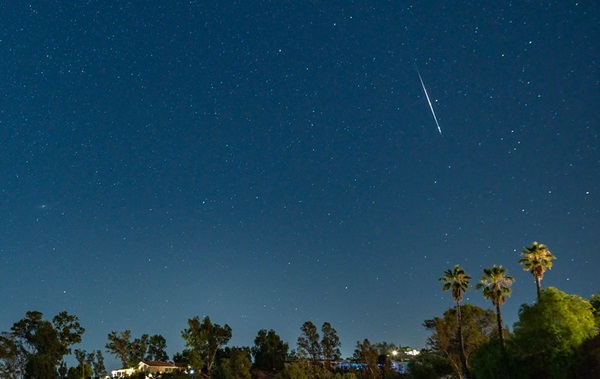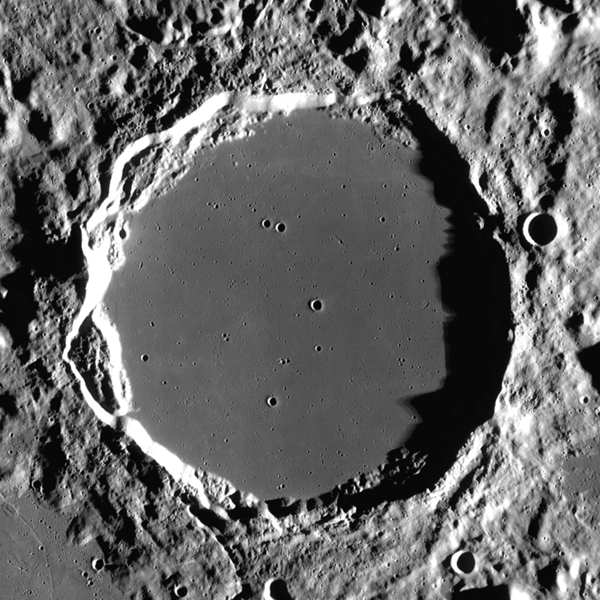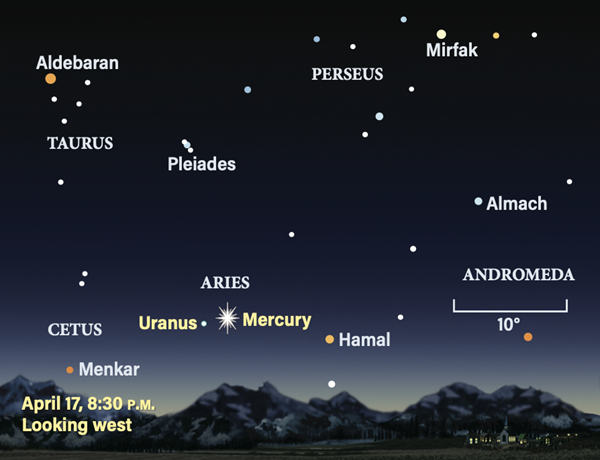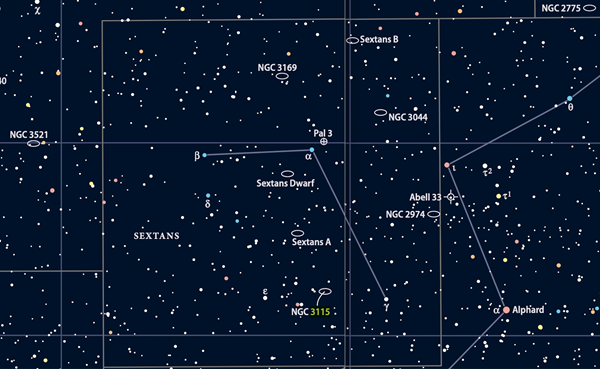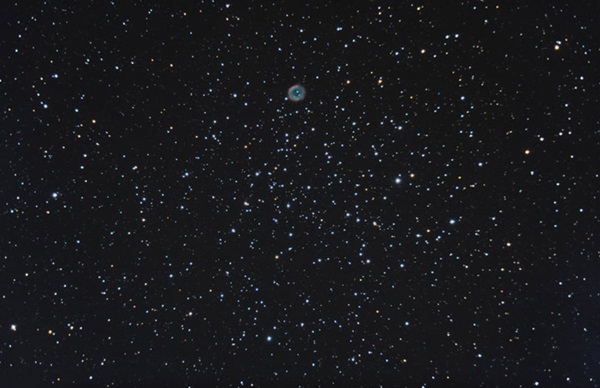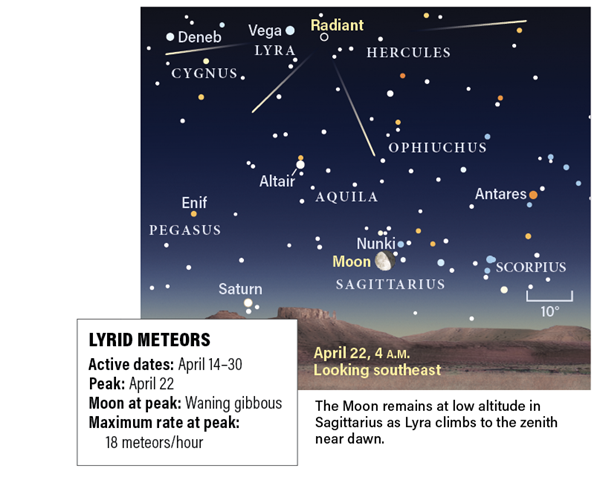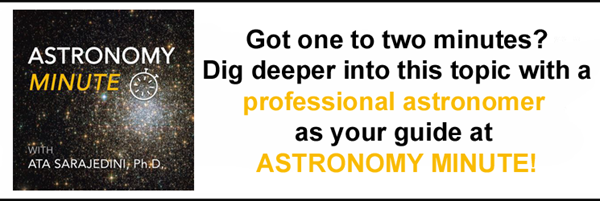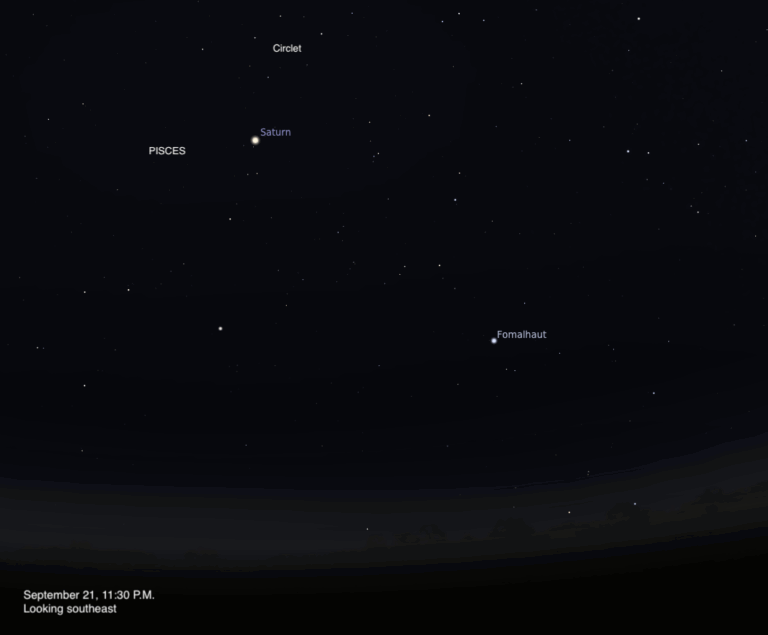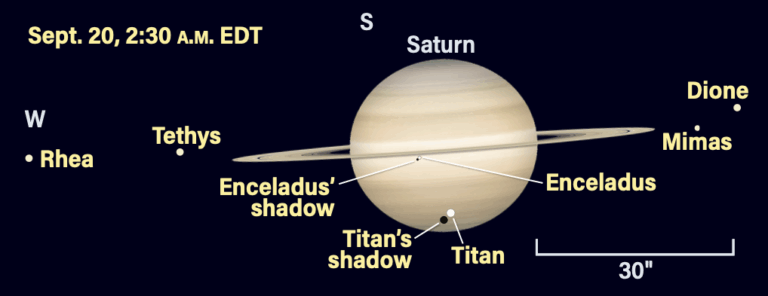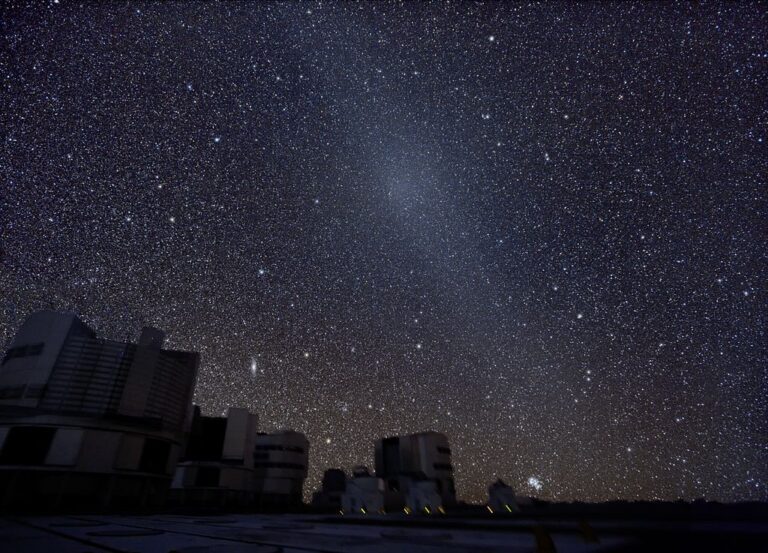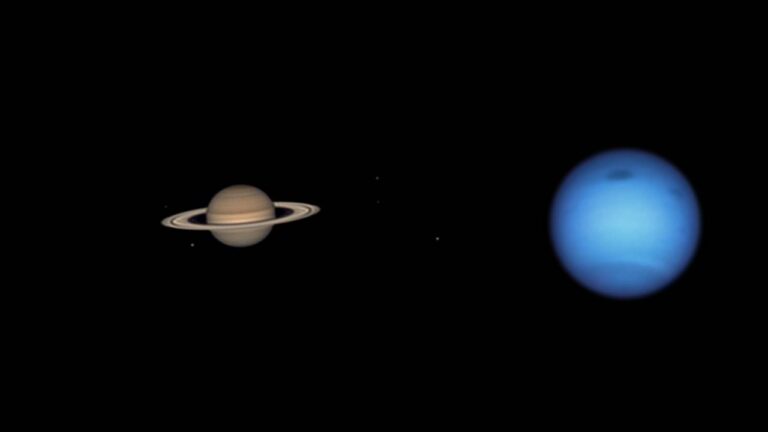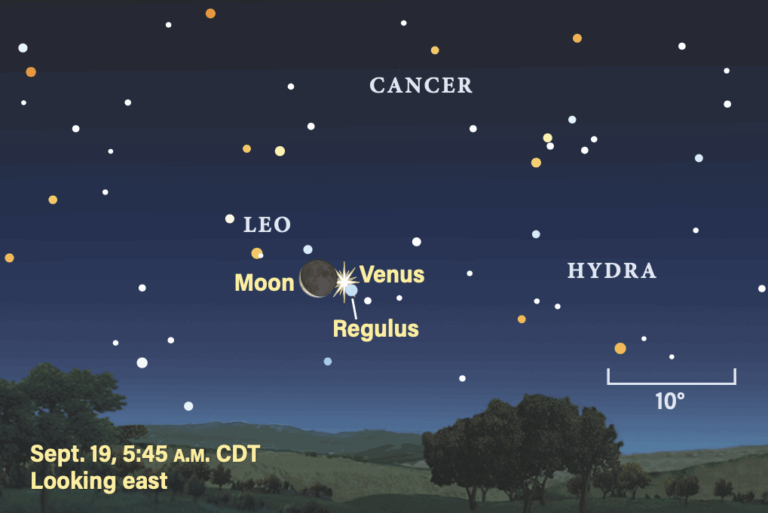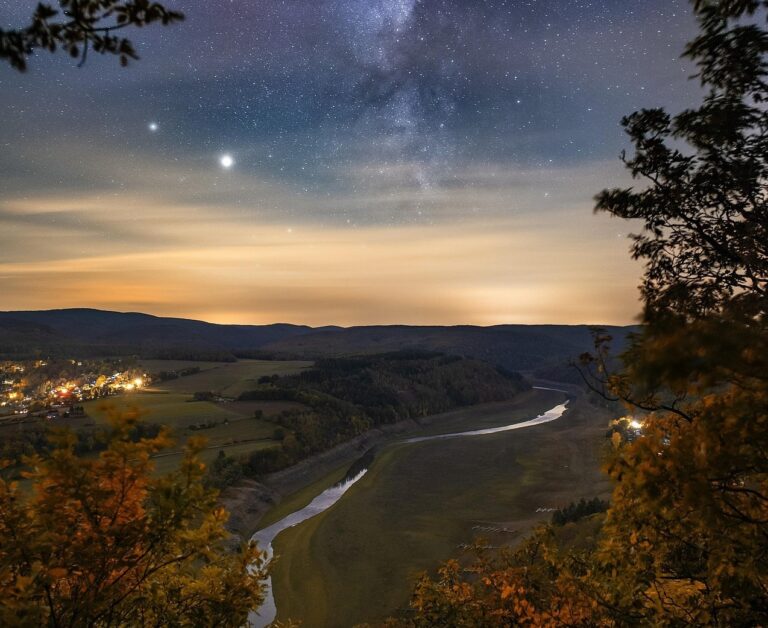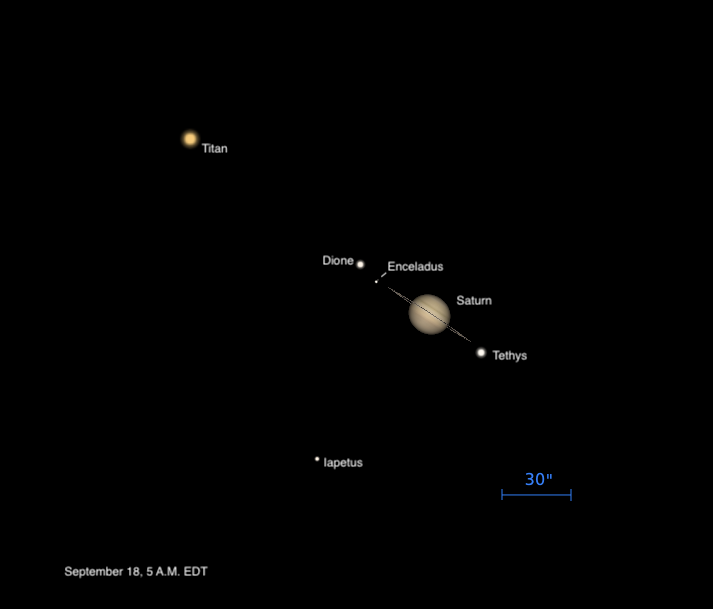Key Takeaways:
Friday, April 15
The constellation Gemini the Twins is high in the western sky after sunset tonight. Its two brightest stars, Castor and Pollux, are cataloged as Alpha (α) and Beta (β) Geminorum, respectively. However, the keen-eyed observer may notice that magnitude 1.6 Castor is ever so slightly fainter than magnitude 1.2 Pollux.
About an hour after sunset, the two are roughly equal in altitude, appearing side by side as the Twins stand upright in the sky. Castor, which has a blue-white hue, is on the right, situated north-northwest of gold-colored Pollux, on the left. Gemini is located directly above Orion at this time, whose belt makes the Hunter easily recognizable.
Zoom in on Castor with a small scope and you’ll see it isn’t a single star but a double: Its two components, Castor A and Castor B, are several arcseconds apart. These stars have a long, wide orbit, which takes about 445 years to complete. A third companion, 9th-magnitude Castor C, lies 1.2′ south.
Sunrise: 6:22 A.M.
Sunset: 7:39 P.M.
Moonrise: 6:36 P.M.
Moonset: 6:01 A.M.
Moon Phase: Waxing gibbous (98%)
*Times for sunrise, sunset, moonrise, and moonset are given in local time from 40° N 90° W. The Moon’s illumination is given at 12 P.M. local time from the same location.
Saturday, April 16
Full Moon occurs at 2:55 P.M. EDT. April’s Full Moon is traditionally known as the Pink Moon, and this year it is also the Paschal Moon — the first Full Moon after the vernal equinox. Tonight, the Moon sits in Virgo, near its brightest star, 1st-magnitude Spica.
With a Full Moon in the sky, most other objects aren’t worth observing. So, let’s focus on the bright Moon, whose rugged terrain comes to life even under low magnification. Notice the dark, ancient lava-filled seas that spread across much of our satellite’s nearside. These darker regions are younger than the brighter, more cratered highlands, which spread across the lunar south. Dominating this region is the large crater Tycho, whose rays of ejecta — material thrown out by the impact that formed it — spread far and wide. Next, move to the lunar northwest (east on the sky), where you’ll find the crater Plato. Look deep within its walls and see how many smaller pockmarks, called craterlets, you can count on its broad, dark floor.
Sunrise: 6:20 A.M.
Sunset: 7:40 P.M.
Moonrise: 7:49 P.M.
Moonset: 6:26 A.M.
Moon Phase: Full
Sunday, April 17
If you often have trouble finding the faint outermost planets Uranus and Neptune, you’re in for a stroke of good luck tonight. Setting slowly after the Sun, magnitude 5.9 Uranus is just 2° from Mercury (magnitude –1.1) tonight.
Wait about 30 to 40 minutes or so after sunset to let the sky grow dark enough for Uranus to stand out. Then, look west to locate brightly shining Mercury, readily visible in the twilight. Zoom in on it with binoculars or a low-power telescope, and you should find Uranus floating to its southeast. Its tiny disk will look like a “flat” gray star. Note that an actual star of similar magnitude, Omicron (ο) Arietis, lies an additional 0.3° south of the planet. Uranus is the object slightly closer to Mercury.
The planets will set a little less than an hour and a half after the Sun.
Sunrise: 6:19 A.M.
Sunset: 7:41 P.M.
Moonrise: 9:03 P.M.
Moonset: 6:54 A.M.
Moon Phase: Waning gibbous (99%)
Monday, April 18
With the now-waning Moon appearing a bit later in the evening, use the time between when darkness falls and our satellite rises to enjoy 9th-magnitude NGC 3115 in Sextans. Known as the Spindle Galaxy — though not to be confused with M102, also called the Spindle Galaxy — NGC 3115 sits just over 3° east of 5th-magnitude Gamma (γ) Sextantis.
If you’re not familiar with Sextans, you’re not alone — this small constellation has no named stars and only five luminaries that carry Greek designations. You’ll find it sandwiched between Leo and Hydra, south of Leo and north of the middle of the Water Snake’s back.
NGC 3115, also listed as Caldwell 53, is bright enough to find with binoculars in a dark sky. But you’ll want a telescope to see a bit more detail, including its slightly oval central region and tapered ends. The galaxy stretches about 8.1′ by 2.8′ on the sky and contains the nearest billion-solar-mass supermassive black hole to Earth, at some 30 million light-years away.
Sunrise: 6:17 A.M.
Sunset: 7:42 P.M.
Moonrise: 10:20 P.M.
Moonset: 7:26 A.M.
Moon Phase: Waning gibbous (95%)
Tuesday, April 19
Four bright planets (and one faint one) outline the ecliptic in the early-morning sky. An hour before sunrise, Jupiter (magnitude –2.1) is just over 2° high in the east and climbing. Nearby is the dimmest world in the lineup: magnitude 7.8 Neptune, which you’ll need some help to pick up. Look for the most distant planet in our solar system just less than 1.5° to Jupiter’s upper right (west). You can use binoculars or any small telescope to capture the ice giant within the same field of view as stunning Jupiter, the latter of which should show off some excellent detail. Can you see the huge planet’s alternating light and dark cloud bands? Its four largest moons are also visible: Callisto (farthest) and Io to its east, and Europa and Ganymede (farthest) to the west.
Just 10.5° west of Jupiter (again, to its upper right in the sky) is Venus, impossible to miss at magnitude –4.2. Turn that telescope on Earth’s sister world and you’ll see that its disk is 63 percent lit. Farther west along the ecliptic is 1st-magnitude Mars, about 12° from Venus. And finally, capping off the predawn planetary display, magnitude 0.7 Saturn sits 9.5° west of Mars, just above 3rd-magnitude Deneb Algedi in the sky. Saturn’s disk spans 16″ and its rings more than double that width, stretching about 37″ across. The gas giant’s largest, brightest moon, Titan, may also be visible. It’s currently sitting about 2.5′ due east of the ringed planet.
The Moon reaches perigee, the closest point to Earth in its orbit around our planet, at 11:13 A.M. EDT. At that time, it will sit 226,890 miles (365,144 kilometers) away.
Sunrise: 6:16 A.M.
Sunset: 7:43 P.M.
Moonrise: 11:37 P.M.
Moonset: 8:04 A.M.
Moon Phase: Waning gibbous (89%)
Wednesday, April 20
Look southwest after sunset and you’ll see Sirius, the blazingly bright nose of Canis Major. East of this bright luminary (upper left on the sky) is the open cluster M46 in Puppis, our target for tonight.
This young grouping of stars shines at 6th magnitude — just visible to the naked eye under ideal conditions, but you’ll want binoculars or, better yet, a telescope to get a good look. M46 spans nearly half a degree on the sky and is composed of stars that are just 300 million years old. Through binoculars, it may look more like a hazy, amorphous glow, while a telescope will show many individual stars.
But in the cluster’s northern regions is a strange sight: a small, ringlike planetary nebula. This seems odd at first, as planetary nebulae are old, dying stars, and open clusters like M46 are young. But there’s a trick of cosmic perspective going on, here: The nebula isn’t part of M46 at all, but simply lies along the same line of sight to the cluster from Earth. Over time, their paths will diverge and the two will no longer appear in the same field of view. So, consider yourself lucky to be alive at this particular cosmic epoch!
Although you might just be able to make out the interloping 10th-magnitude nebula with binoculars, your best bet is to try spotting it with a larger telescope or by taking a photograph. Truthfully, this isn’t the best time to try to see the nebula with only binoculars, as it is setting in a still-darkening sky. Come back in the dead of winter to catch it rising in a far darker sky for the best prospects.
Sunrise: 6:15 A.M.
Sunset: 7:44 P.M.
Moonrise: —
Moonset: 8:52 A.M.
Moon Phase: Waning gibbous (80%)
Thursday, April 21
Comet C/2021 O3 (PanSTARRS) reaches perihelion, the closest point to the Sun in its orbit, today. According to the Comet Observation Database, it is still brightening and currently around 11th magnitude. However, its poor elongation makes this a difficult target, as tonight it sets only about half an hour after the Sun. The comet is now in Cetus the whale, near the bright star Menkar.
PanSTARRS will continue to move northward as the month progresses, increasing its elongation slightly from the Sun and making it easier to spot. Plus, the comet is expected to reach peak brightness early next week as it’s continuing upward into slightly darker skies, so keep an eye on its location (outlined on the chart above) and pull out your telescope as twilight falls to see whether it springs into view.
Even if you miss the comet tonight (admittedly likely), you can instead enjoy Mercury, hanging in Aries the Ram. Since earlier in the week, the naked-eye planet has pulled away from Uranus and stands 6.7° northeast of (directly above) the distant world, which still requires binoculars or a scope to see. If your telescope is at the ready, check out Mercury through it to examine its 7″-wide, 62-percent-lit disk.
Sunrise: 6:13 A.M.
Sunset: 7:45 P.M.
Moonrise: 12:49 A.M.
Moonset: 9:49 A.M.
Moon Phase: Waning gibbous (70%)
Friday, April 22
The Lyrid meteor shower peaks tonight, its radiant rising late in the evening. However, early morning is a great time to try to catch the most shower meteors for those in the U.S. That’s because meteors are always more plentiful in the predawn hours, as Earth’s rotation works for you rather than not against you, causing particles to enter the atmosphere at faster speeds.
The Moon will slightly interfere with your viewing prospects, but not too badly — it remains low on the horizon in Sagittarius this morning around 4 A.M. local time, when the Lyrids’ radiant is higher in the southeast. Located in Lyra the Lyre, you’ll find the radiant near the bright star Vega, appearing just to the right of it in the sky. Look slightly away from this area for the best chances of seeing meteors, as meteor tails are longest some ways away from the radiant.
At its peak, the Lyrids are expected to produce about 18 meteors per hour, though that number will be attenuated this morning by both the viewing geometry and the Moon.
Sunrise: 6:12 A.M.
Sunset: 7:46 P.M.
Moonrise: 1:52 A.M.
Moonset: 10:55 A.M.
Moon Phase: Waning gibbous (59%)

